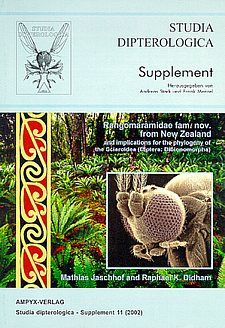 |
Suppl. 1 1997
Suppl. 2 1999
Suppl. 3 1998
Suppl. 4 1998
Suppl. 5 1998
Suppl. 6 1999
Suppl. 7 1999
Suppl. 8 2000
Suppl. 9 2000
Suppl. 10 2002
Suppl. 11 2002
Suppl. 12 2003
Suppl. 13 2005
Suppl. 14 2006
Suppl. 15 2008
Suppl. 16 2008
Suppl. 17 2008
Suppl. 18 2009
Compiled by:
Fritz Geller-Grimm
Contents:
Dr. Frank Menzel
Publishing date of supplement 11: September 20 2002
|
Mathias JASCHHOF & Raphael K. DIDHAM
Rangomaramidae fam. nov. from New Zealand and implications for the phylogeny of the Sciaroidea (Diptera: Bibionomorpha). - [Rangomaramidae fam. nov. aus Neuseeland und die Auswirkungen für die Phylogenie der Sciaroidea (Diptera: Bibionomorpha).] ISBN: 3-932795-16-4 Pages/Seiten: 60 Abstract:
Given that New Zealand´s fauna is of such extraordinary significance for understanding the evolution of the world´s Sciaroidea, it comes as somewhat of a surprise that the study by Tonnoir and Edwards has not inspired subsequent, intensive sciaroid research in this part of the world for the last 75 years. This may be partly explained by the worldwide decline in biosystematic expertize, but also partly because the completeness of Tonnoir and Edwards´ work has apparently been overestimated. As shown in this paper, New Zealand´s sciaroid fauna is far from exhaustively studied. By taking the full methodological advantage of modern, highly effective Malaise trapping, the authors have recently collected and studied a tremendously large and diverse set of samples of Sciaroidea from indigenous forests of New Zealand‘s main islands. This material, supplemented by collections of numerous New Zealand entomologists over the past 20 years, yielded five new species of sciaroid Diptera which are classified in a new family named Rangomaramidae. Adult morphology, biology and distribution of Rangomaramidae ("long-winged fungus gnats") are described and illustrated by numerous line drawings as well as light and scanning electron microscopic images. The origin and evolution of Rangomaramidae are discussed in the context of previous hypotheses on the phylogenetic relationships within Sciaroidea. Rangomaramidae appear to be a relict group of Sciaroidea, with a limited modern distribution and a comparatively small number of extant species. The new taxa may shed more light on the relationship between fungus gnats and gall midges and on the unresolved question of the sister group of Cecidomyiidae.
Key words:
Zusammenfassung: Rangomaramidae, eine neue Familie innerhalb der Bibionomorpha-Sciaroidea, wird aus Neuseeland beschrieben. Die Familie, für die der Trivialname "Langflügel-Pilzmücken" vorgeschlagen wird, umfaßt eine einzige Gattung, Rangomarama gen. nov., mit fünf neuen Arten: R. edwardsi, humboldti, leopoldinae, matilei und tonnoiri. Die neuen Arten werden imaginal-morphologisch beschrieben und ihre Verbreitung und Biologie (Habitatpräferenz, Phänologie) aufgezeigt. Rangomarama edwardsi und tonnoiri sind näher miteinander verwandt als mit anderen Gattungsvertretern, während die verwandtschaftlichen Beziehungen zwischen R. humboldti, leopoldinae und matilei zunächst unaufgeklärt bleiben. Zwischen einzelnen Arten liegt eine beträchtliche morphologische Distanz, was aus Sicht der Autoren für eine lange Zeitspanne der Eigenentwicklung der Rangomarama-Stammlinie spricht. Rangomaramidae ist von anderen Hauptgruppen (Familien oder auf Familienebene nicht klassifizierte Gattungen) der Sciaroidea durch zwei Autapomorphien abgegrenzt: 1) die Verschmelzung der Laterotergite mit dem Mediotergit und 2) die Zweiästigkeit der Subcosta, wobei beide Äste tendenziell in die Costa einmünden. Das Flügelgeäder ist auch dadurch unverkennbar, daß es einerseits relativ stark reduziert ist (z.B. Fehlen des Basalteils der Media und des Radius-Astes 4) und andererseits bestimmte, auch anderen Sciaroidea eigene Merkmalszustände auf charakteristische Weise miteinander vereint (z.B. langer Radialsektor, stark gebogener Radius-Ast 5, Auftreten einer fusionierten Radiomedia). Die Reduktion der Tibialsporne innerhalb von Rangomaramidae und Cecidomyiidae (Gallmücken) weist auf ein mögliches Schwestergruppen-Verhältnis dieser beiden Taxa hin. Die Richtigkeit dieser Hypothese vorausgesetzt, sollte der Ursprung der Rangomaramidae annäherungsweise in den Oberen Jura zu datieren sein. Hohes phylogenetisches Alter, deutliche morphologische Distanz zur nächsten Verwandtschaft, Artenarmut und eng begrenzte geographische Verbreitung sprechen für den reliktären Charakter der Rangomaramidae, die offensichtlich gondwanischen Ursprungs sind. Aufgrund unbewerteter holomorphologischer Ähnlichkeit kann ein Schwestergruppen-Verhältnis von Rangomaramidae+Cecidomyiidae und Sciaridae (Trauermücken) bzw. Sciaridae+X vermutet werden. Die Gallmücken wären damit den Pilzmücken verwandtschaftlich enger angeschlossen als es die meisten früheren Verwandtschaftshypothesen zum Ausdruck bringen. Die Berechtigung einer in der Vergangenheit wiederholt postulierten Überfamilie Cecidomyioidea wird somit nachdrücklich in Frage gestellt. Das Auffinden der Rangomaramidae in Neuseeland unterstreicht nachdrücklich den geringen Grad der Durchforschung südhemisphärischer Pilzmücken-Faunen und die Bedeutsamkeit dieser Faunen für die Erhellung der Phylogenese innerhalb der Sciaroidea.
Stichwörter:
|
 Today´s southern hemisphere fauna and flora are renowned for their transantarctic relationships, dating back to the break up of Gondwanaland by the end of the Jurassic period, some 150 million years ago. Among Dipterists, the southern continents have long been known to provide the habitats for phylogenetically interesting Sciaroidea, an extremely diverse, cosmopolitan group of bibionomorph flies that includes the well known fungus gnats and gall midges. New Zealand is no exception in this respect, where two species, Heterotricha novaezealandiae and Ohakunea bicolor, were described as early as 1927 by A. L. Tonnoir and F. W. Edwards, and remain unplaceable within the current family-level classification of the Sciaroidea. The enigmatic relationships of sciaroids like Heterotricha and Ohakunea are the main reason for the ongoing debate on the higher-level systematics within the superfamily.
Today´s southern hemisphere fauna and flora are renowned for their transantarctic relationships, dating back to the break up of Gondwanaland by the end of the Jurassic period, some 150 million years ago. Among Dipterists, the southern continents have long been known to provide the habitats for phylogenetically interesting Sciaroidea, an extremely diverse, cosmopolitan group of bibionomorph flies that includes the well known fungus gnats and gall midges. New Zealand is no exception in this respect, where two species, Heterotricha novaezealandiae and Ohakunea bicolor, were described as early as 1927 by A. L. Tonnoir and F. W. Edwards, and remain unplaceable within the current family-level classification of the Sciaroidea. The enigmatic relationships of sciaroids like Heterotricha and Ohakunea are the main reason for the ongoing debate on the higher-level systematics within the superfamily.
